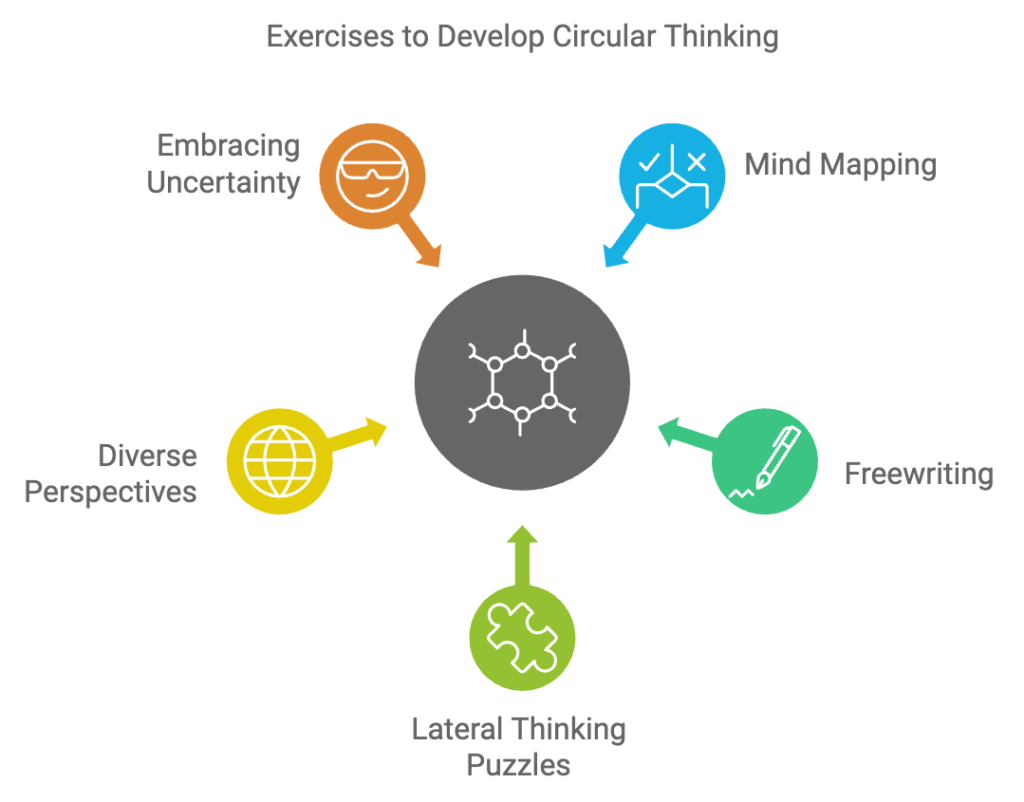Have you ever felt stuck in a mental rut, unable to see beyond the obvious solutions? Or perhaps you’ve had moments where your mind seems to effortlessly connect disparate ideas, leading to brilliant insights?
The way we approach problems and process information can be broadly categorized into two modes: linear thinking and circular thinking. While both have their merits, understanding the distinction between them can unlock new realms of creativity, problem-solving, and personal growth.
In this blog post, we’ll dive deep into the world of linear and circular thinking, exploring their nuances, strengths, and limitations. Buckle up, because we’re about to embark on a journey that will challenge the way you perceive the world around you.
What is Linear Thinking?
Linear thinking is a systematic, step-by-step approach to problem-solving. It’s the mental equivalent of following a straight line, where each subsequent thought builds upon the previous one in a logical, sequential manner.
People who excel at linear thinking are often detail-oriented, analytical, and thrive in environments that value structure and organization. They tend to break down complex problems into smaller, manageable components, tackling each piece methodically until they reach a solution.
Linear thinkers are typically adept at tasks that require focus, concentration, and logical reasoning, such as:
- Mathematical calculations
- Scientific experiments
- Legal analysis
- Financial planning
- Computer programming
While linear thinking is undoubtedly valuable, overreliance on this mode can sometimes lead to rigidity and a lack of creative solutions.
What is Circular Thinking?
Circular thinking, on the other hand, is a more fluid, intuitive, and non-linear approach to problem-solving. It involves making connections between seemingly unrelated ideas, allowing the mind to explore multiple pathways simultaneously.
Unlike linear thinking, which progresses in a straight line, circular thinking is akin to a spiral, where thoughts loop back on themselves, making unexpected connections and generating novel insights.
People who excel at circular thinking often possess traits like:
- Creativity
- Intuition
- Divergent thinking
- Ability to see patterns
- Openness to new perspectives
Circular thinkers thrive in environments that encourage exploration, innovation, and outside-the-box thinking. They are often drawn to fields such as:
- Art and design
- Entrepreneurship
- Advertising and marketing
- Scientific research
- Strategic planning
While circular thinking can lead to groundbreaking ideas, it can also be perceived as unfocused or scattered if not balanced with linear thinking skills.
Linear vs. Circular: The Key Differences
To better understand the contrast between these two modes of thinking, let’s examine some key differences:
Linear Thinking:
- Logical and sequential
- Focused on details and step-by-step processes
- Analytical and data-driven
- Excels at problem-solving within existing frameworks
- Favors structure and organization
Circular Thinking:
- Intuitive and exploratory
- Focuses on making connections and seeing patterns
- Driven by creativity and imagination
- Excels at generating novel ideas and solutions
- Favors flexibility and open-mindedness
It’s worth noting that these two modes are not mutually exclusive; in fact, the most effective problem-solvers often blend elements of both linear and circular thinking.
| Linear Thinking | Circular Thinking |
|---|---|
| Logical and sequential | Intuitive and exploratory |
| Focused on details and step-by-step processes | Focused on making connections and seeing patterns |
| Analytical and data-driven | Driven by creativity and imagination |
| Excels at problem-solving within existing frameworks | Excels at generating novel ideas and solutions |
| Favors structure and organization | Favors flexibility and open-mindedness |
| Well-suited for tasks like mathematical calculations, legal analysis, financial planning, and computer programming | Well-suited for fields like art, design, entrepreneurship, advertising, marketing, and scientific research |
| Follows a straight line, where each subsequent thought builds upon the previous one | Follows a spiral, where thoughts loop back on themselves, making unexpected connections |
| Detail-oriented and focused | Divergent and open to new perspectives |
| Tends to break down complex problems into smaller, manageable components | Tends to explore multiple pathways simultaneously |
| Thrives in environments that value structure and organization | Thrives in environments that encourage exploration and innovation |
The Power of Circular Thinking
While linear thinking is crucial for many tasks, circular thinking offers a unique set of advantages that can lead to breakthroughs and innovations:
a. Creativity and Innovation: Circular thinking encourages us to look at problems from different angles, making unexpected connections that can spark creative solutions. By breaking free from traditional linear constraints, we open ourselves up to new possibilities and fresh perspectives.
b. Pattern Recognition: Our brains are wired to recognize patterns, and circular thinking enhances this ability. By exploring multiple pathways simultaneously, we can uncover hidden relationships and gain deeper insights into complex systems.
c. Problem-Solving: When linear thinking fails to yield satisfactory solutions, circular thinking can provide a much-needed alternative approach. By reframing problems and considering unconventional ideas, we increase our chances of finding novel and effective solutions.
d. Adaptability: In today’s rapidly changing world, the ability to adapt and pivot is essential. Circular thinking fosters flexibility and agility, allowing us to navigate uncertainty and embrace new opportunities.
Integrating Linear and Circular Modes
While it’s tempting to view linear and circular thinking as opposites, the true power lies in their integration. By combining the strengths of both modes, we can achieve a balanced and comprehensive approach to problem-solving and decision-making.
Here are some strategies for integrating linear and circular thinking:
a. Use linear thinking to establish a solid foundation: Begin by breaking down the problem into manageable components and gathering relevant data. Linear thinking can provide structure and organization, ensuring that you have a clear understanding of the core issues.
b. Engage circular thinking to explore new perspectives: Once you have a solid foundation, switch to circular thinking mode. Allow your mind to wander, make connections, and consider unconventional ideas. This can lead to fresh insights and innovative solutions.
c. Alternate between modes: Depending on the task at hand, alternate between linear and circular thinking. For example, you might use linear thinking to analyze data, then switch to circular thinking to brainstorm creative ideas, and then revert to linear thinking to evaluate and refine those ideas.
d. Collaborate with diverse thinkers: Surround yourself with individuals who have different thinking styles and perspectives. Working alongside linear and circular thinkers can foster a dynamic exchange of ideas and lead to more well-rounded solutions.

Exercises to Develop Circular Thinking
While some individuals may naturally gravitate towards circular thinking, it’s a skill that can be cultivated and refined through practice. Here are some exercises to help you develop your circular thinking abilities:
a. Mind mapping: Create visual representations of your thoughts by drawing branches and connections between ideas. This exercise encourages you to explore relationships and patterns that may not be immediately apparent.
b. Freewriting: Set a timer and write continuously without stopping or self-editing. This stream-of-consciousness approach can help unlock your creative flow and allow unexpected connections to emerge.
c. Lateral thinking puzzles: Engage with lateral thinking puzzles and brain teasers that challenge you to think outside the box and consider unconventional solutions.
d. Expose yourself to diverse perspectives: Read books, watch documentaries, or attend lectures on topics outside your usual areas of interest. Exposing yourself to new ideas and viewpoints can spark new neural connections and expand your thinking horizons.
e. Embrace uncertainty: Step out of your comfort zone and embrace situations where the outcome is uncertain. This can train your mind to adapt and think more flexibly, preparing you for the unexpected.
TL;DR
- Linear thinking is a logical, step-by-step approach to problem-solving, while circular thinking involves making connections and exploring multiple pathways simultaneously.
- Linear thinking excels at tasks that require focus, concentration, and logical reasoning, while circular thinking thrives in environments that encourage exploration, innovation, and outside-the-box thinking.
- Integrating linear and circular thinking can lead to more comprehensive and effective problem-solving and decision-making.
- Exercises like mind mapping, freewriting, lateral thinking puzzles, and embracing diverse perspectives can help develop circular thinking abilities.
- Achieving a balance between linear and circular thinking modes is key to unlocking your full cognitive potential.
Linear vs Circular Thinking Quiz
1. Linear thinking is best described as:
2. Which of the following fields is more likely to attract circular thinkers?
3. Integrating linear and circular thinking can lead to:
4. Which exercise can help develop circular thinking abilities?
5. True or False: Linear and circular thinking modes are mutually exclusive.
Q&A
Q: Can someone be equally adept at both linear and circular thinking?
A: While some individuals may naturally gravitate towards one mode or the other, it is possible to cultivate proficiency in both linear and circular thinking through practice and conscious effort. The key is to recognize the strengths and limitations of each mode and apply them appropriately to different situations.
Q: Is one mode of thinking superior to the other?
A: Neither linear nor circular thinking is inherently superior; they are simply different approaches to problem-solving and decision-making. The most effective strategy is to integrate both modes, leveraging their respective strengths to achieve more comprehensive and well-rounded solutions.
Q: Can circular thinking lead to chaos or lack of focus?
A: Circular thinking, if not balanced with linear thinking skills, can sometimes be perceived as unfocused or scattered. However, this is often a misconception stemming from a lack of understanding or appreciation for the exploratory nature of circular thinking.
By embracing both linear and circular thinking, you’ll unlock new levels of creativity, problem-solving, and personal growth. The key is to recognize the strengths of each mode and apply them intentionally to different situations.
Remember, the journey to becoming a well-rounded thinker is an ongoing process. Embrace the challenge, stay curious, and continue exploring the boundless potential of your mind.





